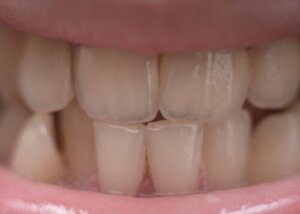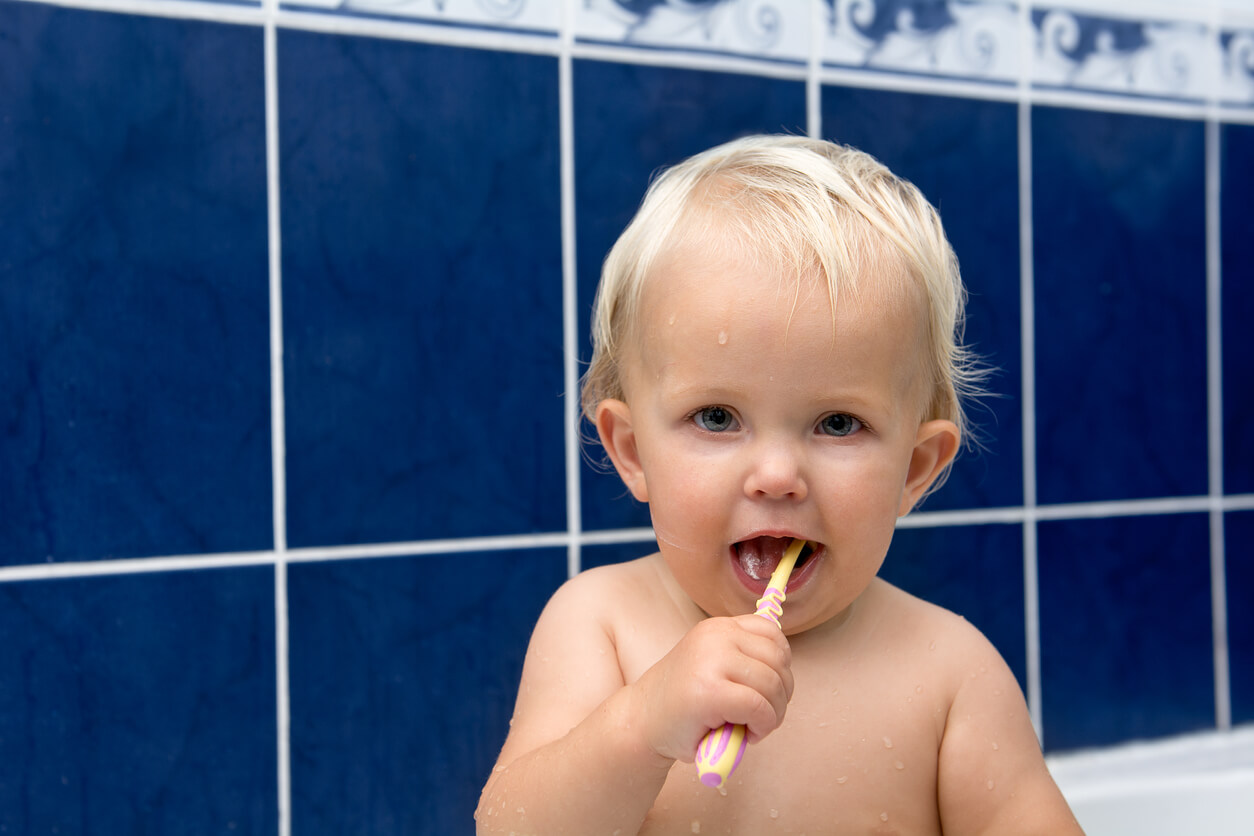Can Fluoride Discolor Children's Teeth?

Many parents ask themselves the following question: Can fluoride discolor children’s teeth? We all know that this element is useful in the prevention of cavities, but not as much is known about its possible risks.
Observing stains on the teeth of the little ones not only causes concern and anxiety in adults. It can also be a cause of concern and embarrassment for children.
In this article, we’ll tell you on what occasions the use of fluoride can stain teeth.
When can fluoride discolor children’s teeth?

Using too much fluoride can irreversibly discolor children’s teeth. This condition is called fluorosis and occurs during the period of tooth formation.
Using large amounts of the mineral during the first years of life, when teeth are forming, can lead to fluorosis. This condition occurs when the elements are inside the bone, under the gum, without having appeared in the mouth. However, it only becomes evident when the teeth erupt.
In most cases, it’s only a change in the appearance of the teeth, which can be seen as white spots or streaks. And in the most severe cases, brown marks, small holes, and a rough surface are evident.
Exposure to too much fluoride can occur through the consumption of water containing excess fluoride, generally in endemic areas. Also, from the overuse of fluoride supplements or using them when they’re not necessary.
Less commonly, fluorosis can happen from habitually swallowing too much toothpaste or mouthwash. However, this isn’t as common, and if your little one accidentally swallows some toothpaste, there’s no need to worry.
The important thing is to measure out the amount of toothpaste on the toothbrush and not apply too much. Talking to your pediatric dentist about how to use fluoride correctly is ideal, as the professional will be able to indicate the right dose according to your child’s needs. Also, keeping dental care products out of reach of the little ones helps to avoid accidents.
Causes of stains on children’s teeth
A stain isn’t the same as the discoloration of teeth. The former are pigmentations on the external surface of the teeth and can originate from different causes:
- Foods or beverages: The regular use of colored foods can pigment tooth surfaces. Drinking tea, soft drinks, and fruit juices are some examples.
- Iron: Iron supplements can deposit on tooth enamel and cause dark stains.
- Incorrect brushing: The accumulation of bacterial plaque stains the teeth and can even calcify and turn into tartar.
Tooth discoloration, on the other hand, happens on the inside of the teeth and these are some of the causes:
- Medications: There are tooth discolorations associated with the use of certain medications. Greenish stains are caused by certain antibiotics, such as tetracyclines or doxycycline during pregnancy or before the age of 8.
- Medical conditions: Suffering from certain systemic problems during the period of tooth formation can alter the appearance of the teeth. Septicemia, jaundice, anemia, and celiac disease are some conditions that affect the child or the mother during pregnancy.
- Trauma: Receiving a blow to a tooth can cause pulp damage and discoloration. If the trauma occurs in a baby tooth, the root of the baby tooth can injure the germ of the permanent tooth that’s forming and alter its appearance.
- Hypoplasias: These are marks on the teeth due to an abrupt interruption in the formation of the enamel. They occur due to conditions during childhood or pregnancy, such as malnutrition, premature birth, high fever, infections, or exposure to toxins.
- Excess fluoride: Fluoride can discolor children’s teeth if consumed in excess during the formative period.
Frequent visits to a pediatric dentist

If you notice a change in color or a strange appearance in any of your child’s teeth, the first step is to visit the pediatric dentist. A dental examination will help diagnose the cause of the stain or discoloration and plan an appropriate treatment.
As we’re talking about children, treatment options should be adapted to the age, the type of dentition affected, and as mentioned above, the cause of the color change.
Frequent visits to the dentist will help detect any problems in time in order to address them as soon as possible. The first visit to the dentist should take place before the first year of life and then continue with check-ups every 6 months.
The dentist is the best person to guide parents in the correct oral care of children. In addition, they’ll be the best source of advice regarding the use of fluorides to prevent cavities, according to the needs of each child. This reduces the chances of the mineral discoloring the teeth that are forming.
Many parents ask themselves the following question: Can fluoride discolor children’s teeth? We all know that this element is useful in the prevention of cavities, but not as much is known about its possible risks.
Observing stains on the teeth of the little ones not only causes concern and anxiety in adults. It can also be a cause of concern and embarrassment for children.
In this article, we’ll tell you on what occasions the use of fluoride can stain teeth.
When can fluoride discolor children’s teeth?

Using too much fluoride can irreversibly discolor children’s teeth. This condition is called fluorosis and occurs during the period of tooth formation.
Using large amounts of the mineral during the first years of life, when teeth are forming, can lead to fluorosis. This condition occurs when the elements are inside the bone, under the gum, without having appeared in the mouth. However, it only becomes evident when the teeth erupt.
In most cases, it’s only a change in the appearance of the teeth, which can be seen as white spots or streaks. And in the most severe cases, brown marks, small holes, and a rough surface are evident.
Exposure to too much fluoride can occur through the consumption of water containing excess fluoride, generally in endemic areas. Also, from the overuse of fluoride supplements or using them when they’re not necessary.
Less commonly, fluorosis can happen from habitually swallowing too much toothpaste or mouthwash. However, this isn’t as common, and if your little one accidentally swallows some toothpaste, there’s no need to worry.
The important thing is to measure out the amount of toothpaste on the toothbrush and not apply too much. Talking to your pediatric dentist about how to use fluoride correctly is ideal, as the professional will be able to indicate the right dose according to your child’s needs. Also, keeping dental care products out of reach of the little ones helps to avoid accidents.
Causes of stains on children’s teeth
A stain isn’t the same as the discoloration of teeth. The former are pigmentations on the external surface of the teeth and can originate from different causes:
- Foods or beverages: The regular use of colored foods can pigment tooth surfaces. Drinking tea, soft drinks, and fruit juices are some examples.
- Iron: Iron supplements can deposit on tooth enamel and cause dark stains.
- Incorrect brushing: The accumulation of bacterial plaque stains the teeth and can even calcify and turn into tartar.
Tooth discoloration, on the other hand, happens on the inside of the teeth and these are some of the causes:
- Medications: There are tooth discolorations associated with the use of certain medications. Greenish stains are caused by certain antibiotics, such as tetracyclines or doxycycline during pregnancy or before the age of 8.
- Medical conditions: Suffering from certain systemic problems during the period of tooth formation can alter the appearance of the teeth. Septicemia, jaundice, anemia, and celiac disease are some conditions that affect the child or the mother during pregnancy.
- Trauma: Receiving a blow to a tooth can cause pulp damage and discoloration. If the trauma occurs in a baby tooth, the root of the baby tooth can injure the germ of the permanent tooth that’s forming and alter its appearance.
- Hypoplasias: These are marks on the teeth due to an abrupt interruption in the formation of the enamel. They occur due to conditions during childhood or pregnancy, such as malnutrition, premature birth, high fever, infections, or exposure to toxins.
- Excess fluoride: Fluoride can discolor children’s teeth if consumed in excess during the formative period.
Frequent visits to a pediatric dentist

If you notice a change in color or a strange appearance in any of your child’s teeth, the first step is to visit the pediatric dentist. A dental examination will help diagnose the cause of the stain or discoloration and plan an appropriate treatment.
As we’re talking about children, treatment options should be adapted to the age, the type of dentition affected, and as mentioned above, the cause of the color change.
Frequent visits to the dentist will help detect any problems in time in order to address them as soon as possible. The first visit to the dentist should take place before the first year of life and then continue with check-ups every 6 months.
The dentist is the best person to guide parents in the correct oral care of children. In addition, they’ll be the best source of advice regarding the use of fluorides to prevent cavities, according to the needs of each child. This reduces the chances of the mineral discoloring the teeth that are forming.
All cited sources were thoroughly reviewed by our team to ensure their quality, reliability, currency, and validity. The bibliography of this article was considered reliable and of academic or scientific accuracy.
- Rivera Martínez, Mercedes Silvana, et al. “Factores asociados a fluorosis dental en niños de 10 a 12 años del cantón Pimampiro, provincia de Imbabura, Ecuador 2016-2017.” Odontología Vital 30 (2019): 51-58.
- León Navarrete, Francisco Javier. Prevalencia de fluorosis y grado de severidad en niños de 7 a 11 años. BS thesis. Universidad de Guayaquil. Facultad Piloto de Odontología, 2019.
- Dominguez, María Eugenia Cabrera, et al. “Prevalencia de fluorosis dental niños de 6–9 años en la localidad de Mochumi.” Salud & Vida Sipanense 4.1 (2017): 2-7.
- Sánchez, Yellin Haygel Medina, et al. “Prevalencia de fluorosis dental, opacidades e hipoplasia del esmalte en niños en edad escolar.” Acta odontológica venezolana 48.3 (2010): 21-22.
- Guerrero-Concepción, Alexander, and Roger Domínguez-Guerrero. “Fluorosis dental y su prevención en la atención primaria de salud.” Revista Electrónica Dr. Zoilo E. Marinello Vidaurreta 43.3 (2018).
- Reséndiz-Vega, Marisol, Raquel A. Mendoza-Schroeder, and Laura S. López-Morales. “Fluorosis dental y su relación con el agua de consumo.” TEPEXI Boletín Científico de la Escuela Superior Tepeji del Río 5.10 (2018).
- Jiménez, Sonia Isela Vázquez, et al. “Tratamiento mínimamente invasivo en un paciente pediátrico con fluorosis dental mediante el uso de microabrasión: reporte de un caso.” ODONTOL PEDIÁTR 28.2 (2020): 103-108.
- CARRASCO MORALES, MARIA BELÉN. Fluorosis dental infantil. BS thesis. Universidad de Guayaquil. Facultad Piloto de Odontología, 2021.
This text is provided for informational purposes only and does not replace consultation with a professional. If in doubt, consult your specialist.








